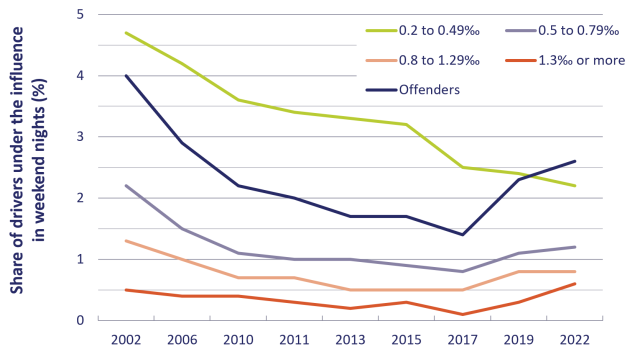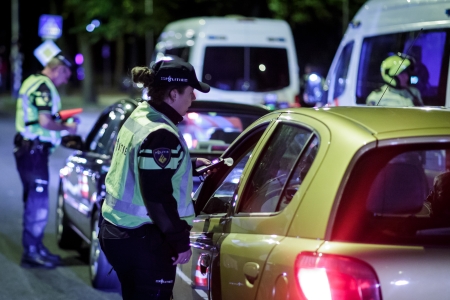Cars
According to the latest measurements (in 2022) of drink driving by drivers in weekend nights, 2.6% were under the influence of alcohol [1]. They had a blood alcohol content (BAC) of 0.5‰ or higher [i]; see Figure 1. The favourable development of alcohol use during weekend nights in 2002-2017 (from 4.1% in 2002 to 1.4% in 2017) reversed to a considerable increase in 2019-2022: an increase of 1.4% offenders in 2017 to 2.6% in 2022. The proportion of serious offenders (BAC ≥ 1.3‰) even increased from 0.1% in 2017 to 0.6% in 2022.

Figure 1. Development of drivers under the influence in weekend nights 2002-2022 (Source: I&O Research [1]).
Among novice drivers (not in Figure), developments are unfavourable as well. In 2019, 2.3% of novice drivers were caught drink-driving (BAC of 0.2‰ or higher), while the percentage increased to 3.7% in 2022. Particularly serious alcohol offences (BAC of more than 1.3‰) increased (more than doubled) from 0.3% in 2019 to 0.8% in 2022.
The study [1] does not explain this negative trend. However, enforcement regarding alcohol use has strongly decreased in recent years. This started as early as 2015-2018 [2] [3]. It is also apparent when considering road user experiences. In 2015, as many as 17% of Dutch drivers said to have been checked for driving under the influence in the past 12 months; that percentage decreased to 10% in 2018 [4]. Conversely, in that same period in Belgium, the percentage of drivers saying they had been checked increased from 17% in 2015 to 24% in 2018 [4]. The Trimbos Instituut, the Netherlands Institute of Mental Health and Addiction, submits that the subjective chance of being caught (road users’ perception of the chance of being caught) has also decreased due to a different set-up of alcohol checks: “The police have discontinued large-scale alcohol checks and have adopted a risk-based approach to alcohol checks. This appears to reduce the subjective chance of being caught for drink driving” (Scholten & Lemmers [5]; p. 47). In COVID-19 years 2020-2021, alcohol checks were even further reduced compared to previous years [6]. All-in all, it is likely that the decrease of (visible) alcohol checks over a longer period contributed to more drink driving (see the question How effective are alcohol checks?).
Bicycles
Night measurements in 2013, the most recent (Dutch) data available, showed that on average 42% of the tested cyclists had consumed more than the legal amount of alcohol (a BAC higher than 0.5‰) [7]. These alcohol measurements were carried out among cyclists in the entertainment area of the cities The Hague and Groningen on Thursday and Saturday evenings and nights/early mornings (5.00 pm to 8.00 am). The percentage of cyclists under the influence increased as the evening/night progressed: at the beginning of the evening none of the cyclists had a BAC above the legal limit, after 1.00 am 68% of the cyclists had a BAC higher than 0.5‰, and after 5.00 am in the morning this was even the case for more than 80% of the tested cyclists
[i] In this fact sheet, the legal alcohol limit is expressed in ‰ (the number of milligrams of alcohol per millilitre of blood); in the Netherlands, a different measure is also often used, the so-called μg/L, micrograms of alcohol per litre of breath.
